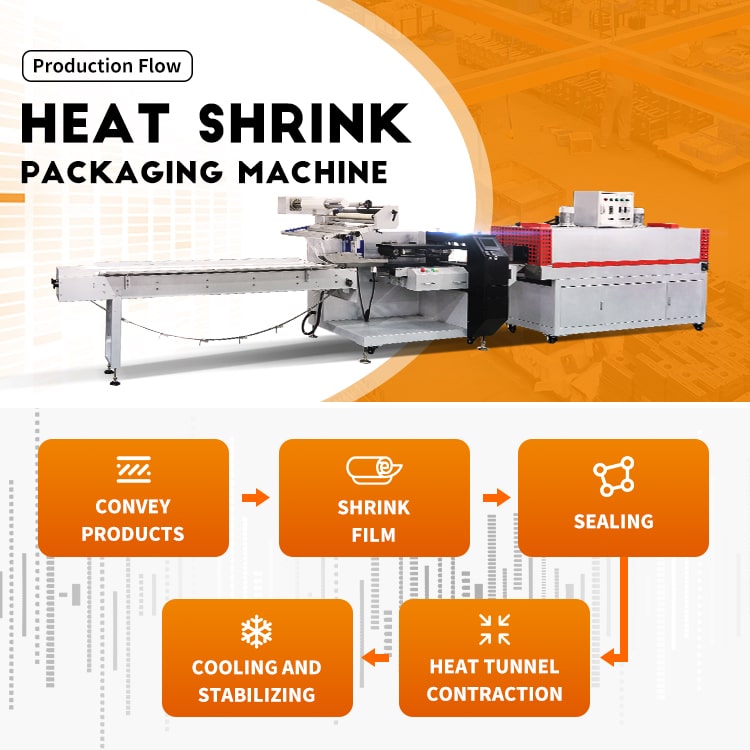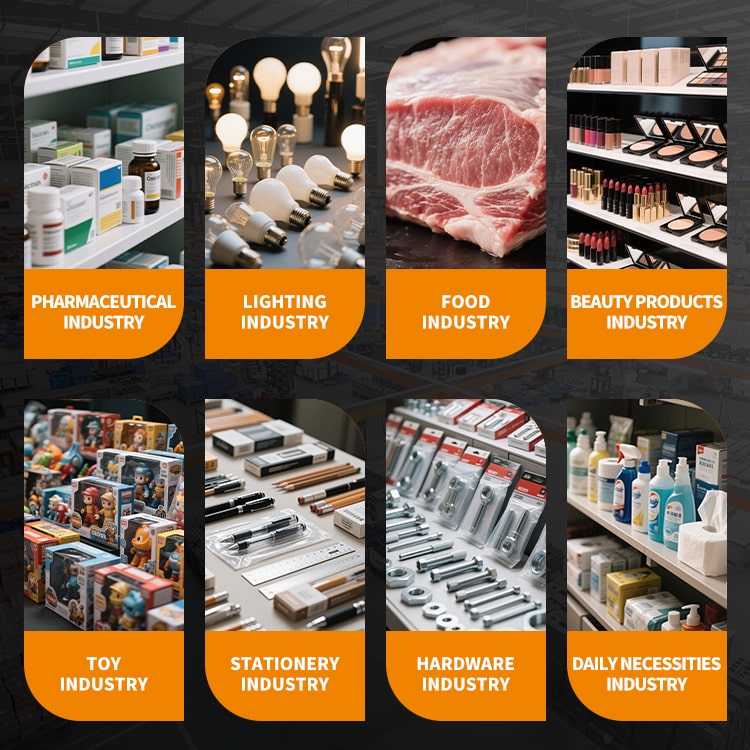Heat Shrink Packaging Machines: Technical Features, Industry Applications
Packaging Knowledge Hub

If you're seeking packaging automation solutions, please contact us, and we'll be delighted to offer you the most tailored solution.
In the dynamic landscape of modern packaging, heat shrink packaging stands as a cornerstone technology, indispensable across a vast array of industries. From securing multi-packs of beverages to protecting delicate electronics, its versatility and efficiency are unmatched. At its core, a heat shrink packaging machine utilizes thermal energy to cause a specialized film to shrink and tightly conform to a product, creating a secure, visually appealing, and often tamper-evident package.
This comprehensive guide will delve into the intricate technical features of heat shrink packaging machines, explore their pivotal applications across key industries, and discuss the strategic considerations for their selection and maintenance. This article is crafted for packaging industry professionals, manufacturing decision-makers, and equipment procurement specialists seeking to optimize their operations and understand the future trajectory of packaging solutions.
Part One: Detailed Explanation of Heat Shrink Packaging Machine Technical Features
1.1 Basic Principles of Heat Shrink Packaging
Heat shrink packaging is a fascinating process built on the unique properties of heat shrink film. These films are specially engineered polymers that, when exposed to heat, undergo molecular reorientation, causing them to shrink and tightly conform to the contours of the product they enclose. Different film materials possess varying shrink ratios and characteristics.
The fundamental working process of a heat shrink packaging machine typically involves several stages:
- Conveying: Products are fed into the machine, often in single units or pre-grouped configurations.
- Film Application/Sleeving: A continuous roll of heat shrink film is applied around the product, either by forming a bag around it or creating a sleeve.
- Sealing and Cutting: The film is sealed and cut to the appropriate size, creating an enclosed or sleeved package.
- Shrinking (Heat Tunnel): The product, wrapped in film, passes through a heat shrink tunnel where controlled heat causes the film to shrink tightly around it.
- Cooling: The package is then cooled, allowing the film to solidify and maintain its tight form.

Various types of heat shrink machines exist to accommodate different packaging needs:
- L-Sealer Shrink Machines: These machines create an "L" shaped seal, suitable for wrapping individual items or small multi-packs.
- Side Sealer Shrink Machines: Offer continuous sealing for high-speed applications, often used for irregularly shaped products.
- Sleeve Wrapper Shrink Machines (Bundlers): Designed for bundling multiple products together, forming a "sleeve" of film around them, with open ends.
- Fully Automatic High-Speed Shrink Machines: Integrated systems that automate the entire process from feeding to discharge, ideal for high-volume production.
1.2 Film Material Selection: The Core of Effective Heat Shrink Packaging
Choosing the right heat shrink film material is paramount to achieving optimal packaging results. Common types include:
- PE (Polyethylene) Heat Shrink Film: Known for its strength, durability, and puncture resistance. It's often used for bundling heavier items like beverage multi-packs or large industrial products. PE film typically offers good clarity but might not be as transparent as other options.
- PVC (Polyvinyl Chloride) Heat Shrink Film: An economical choice, offering good clarity and a strong seal. Historically popular, its use is declining in some regions due to environmental concerns and rigidity at low temperatures.
- PP (Polypropylene) Heat Shrink Film: Offers good clarity, high tensile strength, and excellent gloss. It's often used for retail packaging where appearance is crucial.
- POF (Polyolefin) Heat Shrink Film: A multi-layer co-extruded film, widely considered the most versatile and environmentally friendly option. It boasts superior clarity, strength, tear resistance, and softer seals, making it ideal for a vast range of products, including food.
Comparison of Film Materials:
Selecting the right shrink film material depends on product weight, shape, required clarity, durability, cost-effectiveness, and environmental considerations. The industry is also seeing a growing trend towards eco-friendly heat shrink films, driven by sustainability goals and consumer demand.Feature PE PVC POF Shrink Rate Medium-High Medium High Transparency Good Excellent Excellent Strength High Medium High Cost Moderate Low High Environmental Recyclable Less Eco-friendly Recyclable, Food-Safe
1.3 Energy Saving Technologies in Heat Shrink Packaging Machines
Traditional heat shrink machines can be energy-intensive due to the heat required for film shrinking. However, modern advancements have introduced significant energy-saving technologies to reduce operational costs and environmental impact:
- Variable Frequency Drive (VFD) Technology: This allows for precise control over conveyor and fan motor speeds, adjusting them dynamically based on production speed and load. This means less energy is wasted when the machine isn't running at full capacity.
- Intelligent Temperature Control Systems: Advanced PID controllers and precise sensors maintain optimal heat tunnel temperatures, preventing overheating and unnecessary energy consumption. They ensure the film shrinks effectively without excessive heat.
- Improved Insulation Materials: Modern heat shrink tunnels incorporate superior insulation to minimize heat loss to the surrounding environment, keeping more heat within the tunnel where it's needed.
- Optimized Heating Elements and Air Circulation Systems: Efficiently designed heating tubes and sophisticated air circulation patterns ensure uniform heat distribution within the tunnel, leading to faster and more consistent shrinking with less energy.
- Standby Energy-Saving Modes: Machines can automatically enter a low-power mode during idle periods, significantly reducing energy consumption when not actively processing products.
Choosing an energy-efficient heat shrink machine not only provides substantial economic benefits through reduced electricity bills but also contributes to a lower carbon footprint, aligning with global sustainability initiatives.
Part Two: Industry Case Studies of Heat Shrink Packaging Machines
Heat shrink packaging machines are renowned for their adaptability, making them indispensable across various sectors. Here, we delve into specific industry applications, illustrating the value they bring.
2.1 Packaging Applications in the Beverage Industry
The beverage industry heavily relies on heat shrink packaging machines for multi-pack bundling.
- Case Studies: Think of bottled water, canned sodas, or juice boxes grouped into 4-packs, 6-packs, or 12-packs.
- Advantages of Heat Shrink Packaging for Beverages:
- Secure Bundling: Tightly holds multiple units together, preventing shifting and damage during transport and retail display.
- Ease of Handling: Creates convenient, unitized packages for consumers and retailers.
- Dust & Moisture Protection: Provides a protective layer against environmental elements.
- Promotional Opportunities: Allows for easy creation of multi-buy promotions or sample packs.
2.2 Packaging Applications in the Daily Necessities Industry
Daily necessities often leverage heat shrink packaging for both functionality and promotional purposes.
- Case Studies: Examples include multi-packs of tissue boxes, soap sets, bundled toothbrushes and toothpaste, or shampoo/body wash sets.
- Advantages for Daily Necessities:
- Theft Deterrence: Reduces the risk of individual product pilferage for smaller items.
- Promotional Bundles: Facilitates attractive "buy one, get one free" or value pack promotions.
- Shelf Space Optimization: Creates compact units that are easy to stack and display.
- Brand Presentation: Enhances the overall look and feel of bundled products.
- Theft Deterrence: Reduces the risk of individual product pilferage for smaller items.
2.3 Packaging Applications in the Chemical Products Industry
The chemical products industry utilizes heat shrink packaging for secure bundling, protection, and ease of transport.
- Case Studies: Common applications include multi-packs of paint cans, pesticide bottles, cleaning agent containers, or securing products onto pallets.
- Advantages for Chemical Products:
- Product Stability: Provides robust unitization for oddly shaped or heavy containers, preventing movement and potential leaks during transit and storage.
- Damage Prevention: Protects against physical damage and external contamination.
- Enhanced Logistics: Simplifies handling, stacking, and inventory management for bulk items.
2.4 Other Industry Application Cases
Beyond these core sectors, heat shrink packaging machines find diverse applications:
- Food Industry: Bundling of pre-packaged food items (e.g., ready meals, snack boxes), dairy products, or bakery goods.
- Pharmaceutical Industry: Securing multiple medicine bottles or blister packs, ensuring tamper-evidence and product integrity.
- Electronics Industry: Protecting sensitive electronic components or multi-packing small gadgets against dust and moisture.
- Books & Stationery: Bundling magazines, books, or stationery sets.

Part Three: Selection and Maintenance Guide for Heat Shrink Packaging Machines
Selecting a heat shrink packaging machine is a critical investment that requires careful consideration. Key factors to evaluate include:
- Production Capacity: Match the machine's speed (packs per minute) to your desired output.
- Product Dimensions & Shape: Ensure the machine's sealing area and tunnel dimensions accommodate your largest and smallest products.
- Film Type Compatibility: Verify the machine can work with your preferred heat shrink film material (PE, POF, etc.).
- Automation Level: Choose between semi-automatic, automatic L-sealers, sleeve wrappers, or high-speed continuous motion machines based on your labor availability and desired throughput.
- Budget: Balance initial investment with long-term operational costs, including energy consumption and maintenance.
- Manufacturer Reputation & After-Sales Service: Opt for reputable suppliers who offer strong technical support, spare parts availability, and training.
Routine maintenance and proper upkeep are essential to maximize the lifespan and ensure the stable operation of your heat shrink packaging machine. Key maintenance tips include:
- Regular Cleaning: Keep sealing blades, heating elements, and conveyor belts free of film residue and debris.
- Lubrication: Periodically lubricate moving parts as per the manufacturer's guidelines.
- Component Inspection: Regularly check heating elements, Teflon coatings, conveyor belts, and sealing wires for wear and tear, replacing them as needed.
- Temperature Calibration: Ensure the temperature controls are accurate to prevent film burning or insufficient shrinking.
- Airflow Check: Verify that the heat tunnel's fan and ventilation systems are clear and functioning correctly for optimal heat distribution.
By understanding the technical prowess, diverse applications, and critical selection/maintenance considerations of heat shrink packaging machines, businesses can make informed decisions to enhance their packaging efficiency, product presentation, and overall profitability. Embracing these advanced solutions is key to staying competitive in the ever-evolving packaging landscape.
FAQs
Q1: What is heat shrink packaging, and why is it important in modern industry?
A1: Heat shrink packaging is a widely used packaging method that involves using heat to make a specialized film shrink tightly around a product. It's crucial in modern industry for its ability to provide secure, tamper-evident, and visually appealing packaging, improving product protection and presentation.
Q2: What is a Heat Shrink Packaging Machine, and what is its primary function?
A2: A Heat Shrink Packaging Machine is an automated or semi-automated piece of equipment that applies heat to heat shrink film, causing it to contract and tightly conform to the product. Its primary function is to efficiently create durable and aesthetically pleasing wraps for various products, often for bundling or individual unit protection.
Q3: What types of products can typically benefit from heat shrink packaging?
A3: Many products benefit from heat shrink packaging, including multi-packs of beverages (e.g., bottled water, cans), various daily necessities (e.g., tissue boxes, soap sets), chemical products (e.g., paint cans, pesticide bottles), and even individual items in the food, pharmaceutical, and electronics industries for protection and tamper-evidence.
